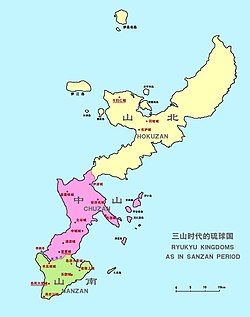Nanzan
| Kingdom of Nanzan | ||||||||
| 南山 | ||||||||
|
||||||||
|
Map of the Three Kingdoms (Sanzan) of Okinawa, with Nanzan in green.
|
||||||||
| Capital | Nanzan Castle | |||||||
| Languages | Okinawan | |||||||
| Religion | Ryukyuan religion | |||||||
| Government | Monarchy | |||||||
| King (国王) | ||||||||
| • | 1337–1396 | Ofusato | ||||||
| • | 1388–1402 | Oueishi | ||||||
| • | 1403–1413 | Ououso | ||||||
| • | 1415–1429 | Taromai | ||||||
| History | ||||||||
| • | Established | 1314 | ||||||
| • | Ryukyu unification | 1429 | ||||||
| • | Japanese invasion | 5 April 1609 | ||||||
|
||||||||
Nanzan (南山), sometimes called Sannan (山南), was one of three kingdoms which controlled Okinawa in the 14th century. Okinawa, previously controlled by a number of local chieftains or lords, loosely bound by a paramount chieftain or king of the entire island, split into these three more solidly defined kingdoms within a few years after 1314; the Sanzan period thus began, and would end roughly one hundred years later, when Chūzan's King Shō Hashi conquered Hokuzan in 1419 and Nanzan in 1429.
Nanzan first came into being in 1314 when Tamagusuku inherited the role of head chieftain of all of Okinawa from his father Eiji; he did not have the charisma or leadership qualities to command the loyalty of all the local lords, and so the Lord of Ōzato, one of many powerful local chieftains, fled south from his home in Urasoe, with a number of lesser chieftains loyal to him, and established himself in Ōzato gusuku near the town of Itoman. Another powerful chieftain fled north and established the kingdom of Hokuzan, leaving Tamagusuku in control only of the central part of the island, which thus became the kingdom of Chūzan.
Nanzan, like the two kingdoms with which it shared the tiny island of Okinawa, consisted of a minuscule territory, and correspondingly limited resources. Nevertheless, the kingdom survived for roughly a century, benefiting from sea trade, and from the advantageous location of Ōzato Castle, situated atop tall bluffs, with an inlet from the sea and its own dedicated dock. Though its ports were not nearly as active as Naha, the chief port of Chūzan, the kingdom enjoyed its share of trade with Southeast Asia, China, and other nearby powers. Chūzan entered a tributary relationship with Ming Dynasty China in 1372. Nanzan was granted similar commercial status shortly afterwards, along with Hokuzan, but was restricted to sending only one ship per tribute mission. Over roughly the next thirty years, nineteen tribute missions were sent from Nanzan to China; Hokuzan sent nine and Chūzan sent fifty-two. Though these missions were meant to be limited to formal trade between the governments of Okinawa and China, it was not unknown for Nanzan officials, like those from the other two kingdoms, to engage in private trade and smuggling. Around 1381, a Nanzan envoy was severely reprimanded for bringing silver into China with which he intended to purchase porcelains for his own personal material gain.
...
Wikipedia

